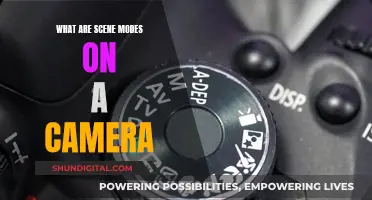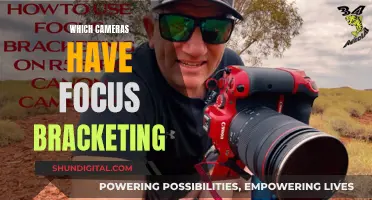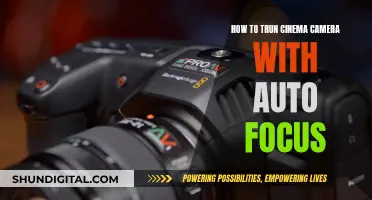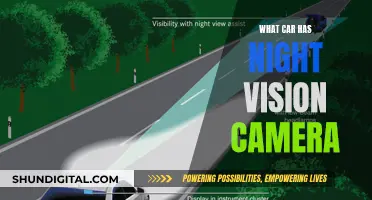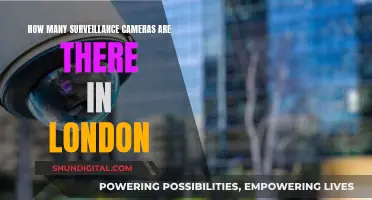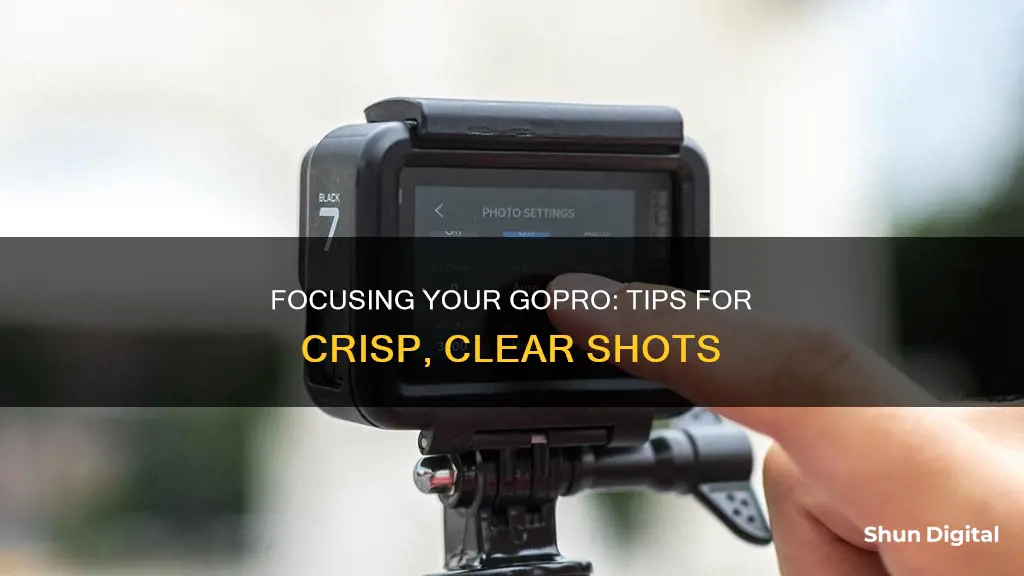
The GoPro is a powerful device with a fixed focus lens, which means that the focus stays the same regardless of the distance of the subject. With a minimum focusing distance of 12 inches or 30 cm, the GoPro is ideal for capturing general scenes, landscapes, and activities rather than extreme close-up shots. Its wide-angle lens and fixed aperture contribute to its ability to keep most things in focus. While it may not be the best choice for close-up portraits or detail shots, the GoPro excels in capturing action and adventure activities, making it a versatile tool for photographers and videographers alike.
| Characteristics | Values |
|---|---|
| Aperture | Fixed |
| Focal Points | None |
| Minimum Focusing Distance | 12 inches or 30cm |
| Field of View | SuperView, Linear, Narrow |
What You'll Learn
- The GoPro has a fixed focus lens, with a minimum focus distance of 12 inches
- The wide-angle lens makes it perfect for capturing action and sports
- It's not ideal for close-up details or portraits
- It's best used for landscapes and general action scenes
- It's a great take it anywhere camera, especially for adventure activities

The GoPro has a fixed focus lens, with a minimum focus distance of 12 inches
The fixed focus lens of the GoPro, combined with its wide-angle lens, results in a large depth of field. This means that a significant portion of the image will be in focus, from relatively close distances to infinity. The wide-angle lens also contributes to the deep depth of field, as it allows for a broader range of the scene to be captured, ensuring that most objects within the frame are in focus.
The minimum focus distance of 12 inches is important to consider when using the GoPro for photography. While it excels at capturing landscapes and action scenes, it may not be the best choice for close-up details or portraits. If you attempt to take extreme close-up shots with the GoPro, they may appear blurry and out of focus. Therefore, it is crucial to maintain a distance of at least 12 inches between the camera and the subject for optimal focus.
The fixed focus lens of the GoPro contributes to its versatility and ease of use. With its ability to keep a wide range of distances in focus, the GoPro is well-suited for a variety of shooting scenarios, from sports and adventure activities to everyday photography. You can simply point and shoot, confident that the entire scene will be in focus, without the need for manual adjustments.
Additionally, the fixed focus lens and minimum focus distance of the GoPro should be considered in relation to other cameras, particularly smartphones. While most smartphones have a shorter minimum focusing distance of around 4 inches (10cm), the GoPro's 12-inch minimum distance is still sufficient for most general photography needs.
Los Angeles Traffic Camera Tickets: To Pay or Not?
You may want to see also

The wide-angle lens makes it perfect for capturing action and sports
The GoPro camera is an action sports camera with a fixed focus and a wide-angle lens. This means that the focus doesn't change if something gets closer or further away, and the wide-angle lens provides a large depth of field, keeping everything in focus from about 1 foot outward. The wide-angle lens is perfect for capturing action and sports for several reasons:
Firstly, wide-angle lenses create increased depth of field, even at larger apertures. This means that more of the image will be in focus, which is ideal for capturing a group of people or a sports team. If you want to create a blur effect in the background and foreground, you can select a larger aperture setting.
Secondly, wide-angle lenses put the subject in context. They allow you to capture the environment and provide a sense of place, which is essential for sports photography. Whether you're photographing a football match, a mountain biking race, or a snowboarder in action, a wide-angle lens will let you capture the surrounding environment, adding drama and impact to your images.
Thirdly, wide-angle lenses are versatile and can be used in both indoor and outdoor settings. They can also focus closer than normal lenses, making them perfect for tight spaces and close-up shots. This versatility ensures that your lens will be handy no matter where you are shooting.
Lastly, wide-angle lenses induce perspective distortion, creating a unique creative effect. The field of view is larger than the size of the camera's sensor, causing straight lines to become curved, especially on the edges of the frame. This distortion can add a dynamic and artistic touch to your sports photographs.
In summary, the wide-angle lens on a GoPro camera is perfect for capturing action and sports due to its increased depth of field, ability to put the subject in context, versatility, and perspective distortion. It allows you to capture dramatic and dynamic images, placing the viewer at the heart of the action.
The Ultimate Battery Pack Guide for Photographers
You may want to see also

It's not ideal for close-up details or portraits
The GoPro is not ideal for close-up details or portraits due to its fixed wide-angle lens, lack of zoom, and minimum focusing distance.
The wide-angle lens of the GoPro is great for capturing immersive, action-packed shots, but it can distort people and make them appear stretched, especially if they are not close to the camera. The lens also has a fixed aperture, which means you cannot select focal points or create a shallow depth of field for portraits with blurry backgrounds.
Additionally, the GoPro does not have optical zoom, only digital zoom, which is essentially just cropping the image. This makes it challenging to capture close-up details, especially in situations like a safari where having a lot of zoom is necessary. The minimum focusing distance of a GoPro is 12 inches or 30 cm, so if you try to do extreme close-up shots, they will likely be out of focus.
To capture close-up details and portraits, a normal DSLR camera or a smartphone with a bigger sensor and optical zoom capabilities would be a better choice. These devices offer more control over settings like aperture, ISO, and shutter speed, allowing for more creative and flexible photography.
Charging Cameras on 'Alone': Powering the Ultimate Survival Show
You may want to see also

It's best used for landscapes and general action scenes
The GoPro is a versatile camera that can be used for landscapes and general action scenes. Here are some tips to get the most out of your GoPro for these scenarios:
Framing the Shot
One of the challenges of using a GoPro is framing the shot effectively, especially with models that don't have a screen. It's important to ensure that only the desired elements are in the field of view and to avoid unwanted objects like branches or grass sticking into the corners of the photo. Proper framing can make all the difference in the final image's composition and impact.
Originality
GoPro users should strive for originality in their shots. While the "hands in front of the GoPro" or "rocking hand out of the water" shots are classic, they have become overdone. To stand out, consider using poles or a handlebar mount to attach the GoPro while walking under a forest canopy or swinging the camera in different directions while walking, swimming, or paddling. Think outside the box to capture unique angles and perspectives.
Planning in Advance
Planning is crucial for successful GoPro photography. It allows you to anticipate the weather, the location, the gear you'll need, and the photo mode and settings. Researching and planning your shots beforehand can significantly increase your chances of capturing the perfect moment.
Shooting at the Right Time of Day
The best time to shoot with a GoPro, especially for landscapes, is during the golden hour—early morning or sunset. The soft, golden light during these times creates a perfect exposure and adds a warm glow to the image. Avoid shooting at midday, as the intense light can negatively impact image quality. If you must shoot during midday, use filters to limit the amount of light entering the lens.
Experimenting with Settings
Familiarize yourself with the various settings on your GoPro to unlock its full potential. Some important settings to explore include time-lapse mode, night lapse mode, and burst mode. Understanding these settings will give you more creative control over your images.
Additionally, here are some specific tips for using your GoPro for landscapes and general action scenes:
- Utilize the super wide-angle lens: The super wide-angle lens with infinite focus and a short hyperfocal distance is ideal for landscape photography, especially when shooting a close foreground. It allows you to capture fine details without worrying about focus or aperture values.
- Shoot in RAW format: RAW format, available in the HERO cameras, allows you to capture a high dynamic range scene and extract highlights and shadow details during post-processing. It is particularly useful for low-light night photos, as it enables efficient post-processing for better detail and lower noise.
- Use Burst Mode with RAW Capture: This feature lets you capture images with high contrast, such as when shooting against light or underwater. You can then enhance shadows and highlights in post-processing to create a more balanced image.
- Stabilization settings: For video stabilization, Hypersmooth is generally recommended for most activities, including travel, hiking, bicycling, sports, and vlogging.
- Shutter Speed: For landscapes and general action scenes, it is typically best to use automatic shutter speed to capture sharp and clear images, especially when there is a lot of movement.
RAW vs JPEG: Understanding Camera Image Formats
You may want to see also

It's a great take it anywhere camera, especially for adventure activities
The GoPro is a versatile, durable, and waterproof camera that is ideal for adventure activities. Its compact size and ease of use make it a great take-it-anywhere camera. Whether you're exploring caves, biking down Death Road, or diving underwater, the GoPro is a reliable companion that will capture your experiences with stunning quality.
One of the key advantages of the GoPro is its ability to handle various environmental conditions. It's completely waterproof out of the box, so you don't have to worry about rain, snow, or diving underwater. The GoPro is also shockproof and dustproof, making it perfect for adventure activities where you might encounter sand, dust, or sudden impacts.
Another standout feature is its SuperSmooth stabilization, introduced with the GoPro 7 and subsequently improved. This feature allows you to capture incredibly smooth videos without the need for bulky additional equipment like a gimbal. The HyperSmooth Boost mode further enhances stabilization, ensuring ultra-smooth footage even in bumpy or unpredictable conditions.
The GoPro also offers a range of convenient features that make it ideal for on-the-go adventures. The Handler accessory, for example, provides a non-slip grip that is perfect for water-based activities and easily packs into your luggage. The Shorty monopod accessory is another useful tool, allowing you to capture natural-looking selfies and extend your reach when filming or taking photos.
The GoPro's versatility extends to its photo capabilities as well. While it may not be your first choice for close-up portraits or fine details, it excels at capturing landscapes and action scenes. The fixed aperture ensures that everything remains in focus, and the various field-of-view options allow you to choose between wide-angle shots or more centred, natural-looking photos.
The GoPro is also well-suited for low-light conditions. Features like Night Mode and adjustable maximum ISO settings help improve image quality in dimly lit environments. Additionally, the RAW photo mode gives you greater control over your images, allowing you to make adjustments using software like Adobe Lightroom.
The GoPro is an excellent choice for vlogging as well. The front-facing screen makes it easy to frame your shots, and the wide lens captures the scene around you perfectly. The Shorty monopod, once again, proves useful for vlogging, as it allows you to maintain a comfortable distance from the camera.
Overall, the GoPro is an incredibly versatile and durable camera that is perfect for adventure activities. Its compact size, ease of use, and range of features make it a reliable companion for capturing your experiences, no matter how extreme or unpredictable they may be.
Smart Doorbell Camera: How Long Does the Battery Last?
You may want to see also
Frequently asked questions
GoPro cameras have a fixed focus lens, meaning the focus stays the same and cannot be adjusted. The minimum focus distance is 12 inches or 30cm.
No, the focus on a GoPro camera is fixed.
GoPro cameras are great for filming extreme sports and everyday activities. They are also useful for taking photos, although they are best used for landscapes or general action scenes rather than close-up details or portraits.


